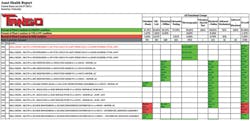How a single database for reliability data delivers optimal outcomes
In this article:
- Unnecessary challenges
- Best-practice alternative
- PdM engineer for a metals manufacturer
- Reliability leader for chemicals and materials manufacturers
- Reliability specialist for an industrial services provider
- Distinguishing characteristics of a single reliability database
- Reliability information centralizing
The array of available tools and technologies for improving equipment reliability is impressive. Individually, they are effective, but together, they can be transformational. Companies that come up short in their reliability goals typically overlook the importance of consolidating the information, because the real key to reliability is information accessibility.
Reliability information is commonly captured in standalone or minimally connected databases. That causes analysts to spend countless hours locating data distributed across the islands of information, and integrating it into useful, actionable information. Sources of data range from structured asset management systems (EAM/CMMS) to predictive maintenance (PdM) tools, sensor-based condition monitoring solutions, assorted specialized apps, an untold number of spreadsheets and emails, and external oil labs and repair shops. Each information island is a missed opportunity.
Instead of sharing comments, activities, and test results via email or secluding them in personal folders, consider democratizing the data in a single, web-based reliability database. This approach allows authorized users to view entire equipment histories at a glance and generate comprehensive reports on the fly. Consolidated condition statuses reveal otherwise-hidden equipment problems, helping to improve work planning, expedite corrective actions, and optimize strategic decision making.
For asset owners, operators, and service providers alike, the transition to a single reliability database of actionable information is invaluable. This article shares perspectives from a metals manufacturer, maintenance service contractor, and reliability consultant about why they embrace the strategy and the advantages being realized. It also outlines key characteristics of a fully optimized single reliability database, such as a web-based design, data standardization, communication, and automatic metrics, to help choose the right path for the journey to reliability excellence.
Unnecessary challenges
Most people in industry have little use for raw equipment data, such as temperatures, vibration spectrums, and decibels. What maintenance, engineering, production, and management need is actionable information, such as the problem, severity, time, and action. For instance, they want to know that a motor has a moderately severe bearing problem that needs to be fixed in the next 90 days, so they can prevent it from failing in service and increase plant uptime and the mean time between failure (MTBF).
CMMS solutions are rarely equipped to track this type of information, especially at the component level, and they tend to be limited, inflexible, and costly to adapt. As a result, it is not uncommon for plants to amass dozens of spreadsheets tracking different reliability variables, such repairs needed, results from repair vendors, equipment locations, equipment design information, and inspection results for the various condition monitoring technologies.
Furthermore, different individuals, departments, or sites may have their own variations of the same or similar records, often with different naming conventions. When a spreadsheet owner leaves, their replacement may not understand or continue the program effectively, or they may be unaware of or unable to locate the file.
Maintenance and reliability managers become inundated with bits and pieces of information from in-plant technicians and external contractors, oil labs, and repair shops, and they never really look at all the reports. Third-party service partners who track work in their own separate databases are at risk of communication gaps and miscommunication with their customers.
Companies with these reliability issues tend to overemphasize technical proficiency in collecting data and fall short in managing the coordination of information. As a result, the program’s value is limited and prone to falling apart.
Best-practice alternative
Establishing a single, centralized, web-based database is a reliability information management (RIM) best practice, and foundational for effective reliability-centered maintenance (RCM) programs. Besides helping to fully leverage each individual reliability tool’s strategic value, it also supercharges maintenance and reliability decision-making across the enterprise.
Because equipment information needs for managers, planners, field technicians, engineers, reliability analysts, and contractors are shared yet distinctive, capturing it in a single database provides everyone from the plant floor to the executive suite, and chosen service providers, with ready access to a single source of the truth with common formatting, reporting, and metrics.
Adopting this approach does not necessitate investing in years of costly data conversions, software integrations, or artificial intelligence. Rather, it redirects analyst efforts in a manner that enables them to be more efficient at what they do best – turning data into actionable information.
These analysts are already making findings and recommendations, so instead of entering them into some email or spreadsheet, why not enter them in the single database instead? No extra effort is required to redirect actionable information to a place that produces greater value. Optionally, when time permits, historical data from the distributed databases can be added to the consolidated database.
Managers with on-demand access to the single database’s integrated condition status report (ICSR) will readily see compliance metrics for routes, employee performance, third-party performance, machines at risk, and how many days condition problems are overdue. Service providers who share access to a web-hosted single database can connect and communicate their expertise directly, rather than issuing reports.
Why data sharing is a two-way street
Avoiding the black hole of data
Turning data into quality information for making better decisions
Industry research supports the underlying purpose and importance of the strategy. Terrance O’Hanlon, executive director of the Association of Asset Management Professionals (AMP), published the results of an informal poll on RCM he conducted in July 2020 on LinkedIn. Though his post did not explore or propose solutions, the results underscore the value of having a single reliability database with actionable information.
The survey asked: What is the #1 reason that RCM implementation has such a low sustainable success rate? Votes from the 376 respondents attributed:
- Not enough manpower = 8%
- RCM lost in CMMS translation = 10%
- Lack of executive sponsorship = 35%
- Cultural resistance to new RCM = 48%
O’Hanlon observed that 82 percent of the RCM failure causes have nothing to do with the technical process of RCM analysis.
Here is how using a single reliability database helps to overcome the four stated challenges:
- Manpower availability increases when the need to manually compile reliability information from numerous disparate data sources is eliminated.
- Translation challenges inherent with CMMS are avoided with a purpose-built reliability database.
- Executive sponsorship is sustained when volumes of disconnected reports are replaced by consolidated, visual, automatic metrics available on demand from anywhere.
- Cultural resistance is alleviated when it is known that any new RCM information will be centralized, standardized, and accessible, and not languish in isolation.
Users of a single reliability database are experiencing dramatic improvements in reliability performance.
PdM engineer for a metals manufacturer
Andy Robinette, lead PdM engineer for North American Stainless (NAS) credits a single reliability database for providing a platform for collaboration between the plant’s mechanical maintenance and predictive maintenance groups. “With as many assets as we have, spread across multiple buildings, managing disparate information used to be a challenge,” he says.
“The main advantage of the centralized database is that you can pull up the current status and full history of a piece of equipment at a glance, from anywhere, instead of digging through files and manually assembling data from months or years of paper reports,” adds Robinette.
To stay on top of reliability threats, he uses a report from the database to conduct monthly “reds meetings” to review the most urgent, red-coded asset conditions with the line engineers.
Root cause failure analysis (RCFA) capabilities were added to solve the problem of engineers each having their own way of tracking and following up on breakdowns. “It brought all the information into one place where everybody now documents their information the same way and the knowledge is shared,” Robinette explains.
Even the manufacturer’s service partners use the database. Previously, vibration analyst contractors reported abnormal equipment conditions with recommended actions to the plant engineers through email, and any feedback and follow-up was also emailed. Now, the analysts and engineers document everything in the shared database, all reporting is centralized, and feedback is exchanged directly using a comment feature, eliminating almost all individualized email communication.
Current State of Reliability Management:
- Distributed Information
- No Standardization
- No Integration
- Poor Communication
- Poor Accountability
- Unable to Analyze Performance
Reliability Information Management Best Practices:
- Consolidate Reliability Information in a Single Database
- Manage Actionable Information, Not Raw Data
- Track Both Location and Equipment Reliability Information
- Centralize Management of All Condition-Based Assessment Tasks
- Include Walk-Around Inspections in the Reliability Program
- Present all Actionable Health Information in a Single Condition Status Dashboard
- Use “Reds Meetings” to Create Accountability for Follow-up on the Dashboard
- Integrate Results from Repair Vendors
- Identify Bad Actor Locations and Assets
- Document and Manage Corrective Actions Coming from Root Cause Cases
- Document Reliability Cost Benefits for the Business
- Track Reliability Program Performance Metrics
The integration of asset health and work management in a single dashboard.
Reliability leader for chemicals and materials manufacturers
Kevin McGehee, now principal owner at Branch and Vine Consulting, drove the process of consolidating reliability information into a single database for two different manufacturers. “They needed the ability to report up to senior-level management status information for an entire corporation with multiple sites and many production units,” he says.
He correlates the personal challenge of overseeing financial information, held in multiple institutions and accounts with different logins and passwords, to the problem faced by many who deal with reliability information for highly valuable production processes. “Everyone is busy, wearing multiple hats, and frankly, there isn’t time to go looking in multiple locations for needed information,” explains McGehee.
A common problem with other methods he tried is keeping all the information from different production units or sites “apples to apples.” Moreover, hiring someone to gather, condense, and report the information for the people who need it costs a significant amount of money.
“With little to no effort, a single, centralized reliability database condenses the information into a simple, easy-to-understand exception report ranked by what’s most important to the user,” says McGehee. “It provides everyone with a single source of the truth, with common formatting, reporting, and performance metrics. Directors and managers can now see information aggregated for the entire corporation and details all the way down to each production unit. A maintenance supervisor or planner can easily get exactly what is needed for their own area of responsibility.”
Reliability specialist for an industrial services provider
Chad Anderson, reliability specialist at Equipment & Controls, Inc. (ECI), an industrial services provider, observes that having information in multiple databases makes it difficult to track assets. “I have seen separate databases for pump installations: one for the electric motors, and the other containing the pump information. I want to see the pump/motor combination and how they perform together,” he says. “Our single reliability database allows the entry of unique identifiers for each component, making it possible to track them separately as well.”
The option exists for service providers to manage multiple customers in a single database, while still securing access to the intellectual property. This provides visibility into assets that are common across multiple customers and industries, enabling a broader historical perspective and proactive application of corrective actions. “It is also convenient for tracking assignments and for using automatic scheduling functions in the centralized database,” adds Anderson.
The results of multiple technologies in a single view of asset health.
Other customer accounts are housed in an exclusive database. This includes larger corporate clients with many individual plant sites as well as customers who regularly access and interact with the shared database, provide feedback to the service provider through the database, and actively track individual components.
Distinguishing characteristics of a single reliability database
A centralized reliability database helps users to understand the true condition status of critical equipment by integrating information from sources such as CMMS systems, vibration analysis, infrared thermography, oil analysis, ultrasound, motor testing, and repair records.
Well-developed centralized databases may contain information spanning the entire lifecycle of the asset and its components, such as engineering and design, procurement, bill of materials, warranties, criticality, testing and inspections, condition monitoring data, calibration, maintenance and repairs, failure analyses, contractor activity, replacement, disposal, and cost accounting. Combining information from multiple sources about a given asset increases confidence in the analysis. Optional integration with the CMMS can automate work order generation.
A single reliability database with the following technical and functional qualities is designed to drive reliability optimization.
Technological attributes:
- Web-browser access: Web-based deployment permits authorized employees, contractors, oil labs, and repair vendors to view and enter data online, in real-time, from any location into the centralized database.
- Purpose-designed portals: Employees, vendors, and contractors each have unique information needs that are best provided by personalized portals.
- Automatic equipment and reliability metrics: Too many plants spend hours each month compiling program metrics for compliance, at-risk components, time to repair, top failure modes, and asset health. Automating the process of generating useful metrics from a single reliability database saves time and improves performance management.
Functional core:
- Actionable information: What maintenance and reliability professionals need is actionable information. Raw data is best left in inspection systems.
- Communication: The ability to control emails and dashboards based on personal needs and roles fosters effective communication.
- Standardization: Enforcing consistency and conciseness in single database entries avoids miscommunication, accelerates analysis, and facilitates searches and the use of drop-down lists. Standardizing nomenclature, such as location names, failure modes, faults, severity levels, and descriptions across all reliability activity, including vibration, thermography, ultrasound, and more, promotes integrated analysis and metrics.
- Integrated information: Integration of reliability information is best performed after standardization is complete. It is the process of aggregating and consolidating condition information from analysts, which is derived from reliability inspection technologies that capture technical data and from the CMMS.
- Integrated analysis: Blending condition data from multiple PdM and sensor technologies along with failure modes and MTBF information supports optimal reliability analysis.
- Integrated metrics and reporting: With a single, integrated reliability database, all metrics and reports are completed in one place instead of piecemeal across multiple data sources. Automatically generated metrics concisely articulate the status, constraints, and value of the reliability program using visually oriented dashboards and reports.
- Historical perspective: Accessing and analyzing asset inspection and failure results over many years is game changing. Having all the information in one database, instead of different spreadsheets and emails, provides much better insight into the reliability program’s performance. Understanding patterns, faults, bad-actor assets, their locations, and repair histories provides the foundation for RCFA and continuous improvement.
- Accountability: Understanding who is responsible for reliability decisions and actions, and the expected completion of the actions, is vital to ensuring follow-through and expediting activity where needed.
Reliability information centralizing
Clear understanding of asset health statuses, assets at risk, and bad actor equipment is fundamental to increasing operational safety, efficiency, productivity, and performance. Centralizing integrated reliability information in a single database accelerates awareness of emerging risks, allows actions to be scheduled to avoid the failure, enables analysts to reveal the root causes of the failure, and improves management oversight. It is an unparalleled best practice for reliability program optimization.
This story originally appeared in the August 2021 issue of Plant Services. Subscribe to Plant Services here.




